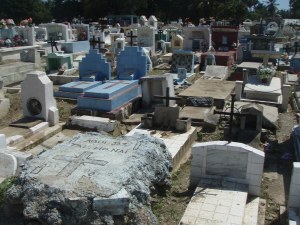 Last Sunday I joined a group of eight divers and two guides for a diving trip to Atauro island, the small island 30 kilometers north of “mainland” Timor-Leste. Atauro was used by the Indonesians as a prison during the occupation, and the few residents there now are largely families who, after as long as twenty-five years, elected to stay after the occupation ended in 1999. The side of the island facing Dili has a mostly rocky shoreline, and steep inclines down to the water. Like the rest of Timor-Leste, Atauro is mountainous, with few villages and only a few kilometers of dirt road. We were headed for the other side of Atauro, facing away from Timor island, where there are rocky beaches and a spectacular reef wall.
Last Sunday I joined a group of eight divers and two guides for a diving trip to Atauro island, the small island 30 kilometers north of “mainland” Timor-Leste. Atauro was used by the Indonesians as a prison during the occupation, and the few residents there now are largely families who, after as long as twenty-five years, elected to stay after the occupation ended in 1999. The side of the island facing Dili has a mostly rocky shoreline, and steep inclines down to the water. Like the rest of Timor-Leste, Atauro is mountainous, with few villages and only a few kilometers of dirt road. We were headed for the other side of Atauro, facing away from Timor island, where there are rocky beaches and a spectacular reef wall.
The dive boat, a powerful twin-engined craft, was outfitted to accommodate ten divers and their equipment. The skipper, an Australian expat, appropriately named “Rocket” (don’t call him Rodney, his given name) is an expert dive boat pilot, skilled at following divers’ bubbles during “drift dives,” where the divers drift along with the current as it flows laterally along the reef.
Shortly after casting off in Dili, Rocket discovered that we did not have a shade fly for the open area at the stern half of the boat. So he stopped alongside a schooner moored in the bay to borrow one from the skipper, another Aussie expat who lives on his boat. The two skippers exchanges pleasantries, a fly changed hands, they got caught up on the day’s events, and they apparently wished each other a good day. In the entire verbal exchange, the only word I understood was “mate,” which constituted a frequent and no doubt important part of the dialogue. That done, off we went for Atauro.
The sea between Timor island and Atauro can get rough, with whitecaps picked up by the northeasterly trade winds. The channel between is very deep, about 3,800 meters, and dolphins and pilot whales are regularly sighted there. The roughest part of the sea is in the middle third of the passage – Rocket’s domain. He blasted the boat through the waves with obvious skill and satisfaction, crashing into the troughs with purpose, sending sheets of seawater shooting off the bow and directly into my face, having had the lack of foresight to choose a seat amidship on the windward side.
As we approached the leeward side of the island, the sea flattened, my stomach muscles relaxed, and I began assembling my gear. The dive boat does not seem crowded with ten people aboard when all the gear is stowed. But ten people struggling to put on wetsuits and tanks gets a bit chaotic in a confined space, and it was mildly surprising to me that no one was poked in the eye or went overboard in the effort.
Taking a breather with my wetsuit half on, I looked ahead to a large patch of water that looked like boiling seawater. As we approached, the churning water turned out to be a huge school of dolphins. There were so many animals it almost seemed like you could walk on their backs across the water. Rocket looped the boat around to give us a better view; and the dolphins seemed to be watching us as they swam and jumped in graceful arcs alongside the boat.
Rocket dropped us off at the mouth of a small cove, and after coordinating signals among the divers, we descended on the ocean side of a huge reef wall. The wall was like a cliff, extending sharply downward from about 10 meters below the surface to an unknown depth. At 20 meters, I could not see the bottom. I imagined dark shapes in the darkness below – an uneasy feeling. The reef was a very dramatic spectacle, a vertical coral wall festooned with soft colorful corals and teeming with fish. We drifted along at a depth of about 20 meters, taking in the breathtaking scenery, until we surfaced next to the boat.
I swam ashore after the first dive, and dozed in the sun for the requisite hour to allow accumulated nitrogen from the first dive to dissipate from my body.
The second dive was equally beautiful, but different. The reef at the second site was more spread out, with coral heads extending up from a steeply sloping sandy bottom. The corals were more vibrant here, because the sunlight was not obscured by a reef wall.
On the passage back to Dili we passed the school of dolphins again, and weaved in and out of the school for a closer look at them. I stayed drier on the return, having chosen a seat on the leeward side of the boat.





Recent Comments